
The Steller’s jay is one of the more common birds Yosemite visitors see. It has beautiful blue feathers that aren’t blue at all--that is, they have no blue pigment in them. This is also the case with Yosemite’s mountain bluebirds. Birds with yellow or red feathers usually get their color from pigments in the foods they eat, but the digestive process destroys blue pigments. So how do feathers on mountain bluebirds or Steller’s jays get their blue color?
Feathers are made of keratin, the same stuff your fingernails are made of. As a feather that will become blue grows, keratin molecules grow inside each cell, creating a pattern. When the cell dies, a structure of keratin interspersed with air pockets remains. As sunlight strikes one of these feathers, the keratin pattern causes red and yellow wavelengths to cancel each other out. The blue wavelengths reflect back, giving the feather its color. Different shapes and sizes of air pockets and keratin make different shades of blue. This is what scientists call a structural color (as opposed to pigmented color.)Next time you see a Steller’s jay or a bluebird consider the amazing way nature has colored its feathers.

